Olympus E-510
-
-
Written by Gordon Laing
Olympus E-510 resolution comparison
| Support this site by shopping at Amazon | |||||||||||||||||||||||||||
 |
To measure and compare the Olympus E-510’s resolving power we photographed the Enhanced Digital Camera Resolution Chart with it and a number of rival models, each using their best quality JPEG and default image tone and sharpening settings. We tested the E-510 using both the kit Zuiko Digital ED 14-42mm lens and the Leica D 14-50mm. The crops are taken from the original images, saved as High Quality JPEGs in Photoshop CS2 and presented here at 100%. Each number represents 100 lines per picture height (lpph), so a figure of 20 means a resolution of 2000 lpph. |
|
We tested each camera and lens combination at every aperture and selected the sharpest results – in each case this was achieved at f8. Fitted with the Zuiko Digital 14-42mm ED kit lens, the E-510 delivered 2150lpph of horizontal and vertical resolution. This result is identical to the E-410, which isn’t surprising, since both cameras share the same sensor and image processor, and we also fitted each body with the same 14-42mm kit lens to avoid manufacturing variations. Fit the Olympus body with a higher quality lens and you’ll enjoy slightly higher resolution. As with the E-410, we measured a fractional improvement when using the Leica D 14-50mm zoom. The big difference between the E-510 and E-410 results below though are their default image processing settings. Since we believe most people will use their cameras with their default image processing settings, that’s what we use for testing and comparison. As such, the E-510 and E-410 were tested here using their Natural and Vivid Picture Modes respectively. Natural mode is clearly not as punchy as Vivid and appears to deliver softer results, but this is mostly down to sharpening and contrast levels. Upon close inspection, the E-410’s result doesn’t actually contain any extra detail, but if you prefer punchier output direct from the camera, you should set the E-510 to its Vivid mode. If you prefer to apply enhancements in software later, you may find the default Natural mode more appropriate. The bottom line though is the E-510, like the E-410, is capable of resolving a great deal of detail with its kit ED 14-42mm lens – indeed it’s equivalent to the best 10 Megapixel DSLRs we’ve tested. Note the Olympus bodies do have a technical advantage here though as their 4:3 aspect ratio means they enjoy a slightly higher vertical resolution than models with a more traditional 3:2 aspect ratio. This test chart measures lines per picture height, so vertical resolution is key. |
Olympus E-510 using ZD 14-42mm ED |
Olympus E-510 using Leica D 14-50mm | |
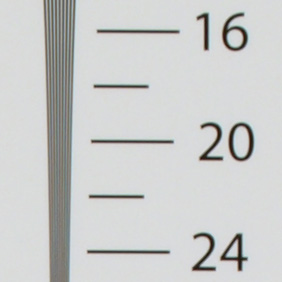 | 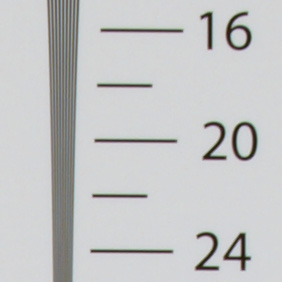 | |
2150 lpph, 14-42mm at 25mm, f8, 100 ISO |
2175 lpph, 14-50mm at 25mm, f8, 100 ISO | |
Olympus E-410 using ZD 14-42mm ED |
Canon EOS 400D / XTi with EF-S 18-55mm | |
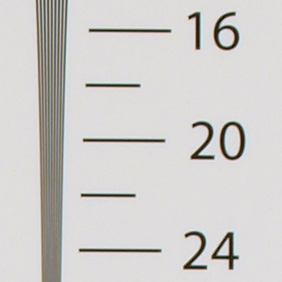 | 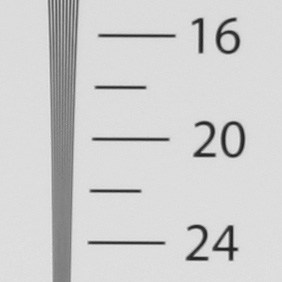 | |
2150 lpph, 14-42mm at 25mm, f8, 100 ISO |
2000 lpph, EF-S 18-55mm at 35mm, f8, 100 ISO |
Olympus E-510 using ZD 14-42mm ED |
Olympus E-510 using Leica D 14-50mm | |
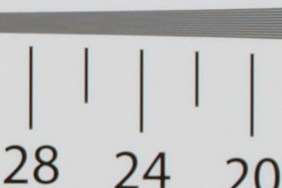 | 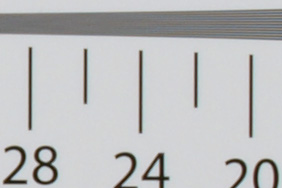 | |
2150 lpph, 14-42mm at 25mm, f8, 100 ISO |
2175 lpph, 14-50mm at 25mm, f8, 100 ISO | |
Olympus E-410 using ZD 14-42mm ED |
Canon EOS 400D / XTi with EF-S 18-55mm | |
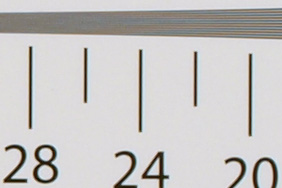 | 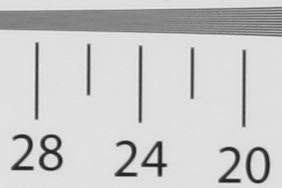 | |
2150 lpph, 14-42mm at 25mm, f8, 100 ISO |
2100 lpph, EF-S 18-55mm at 35mm, f8, 100 ISO |




